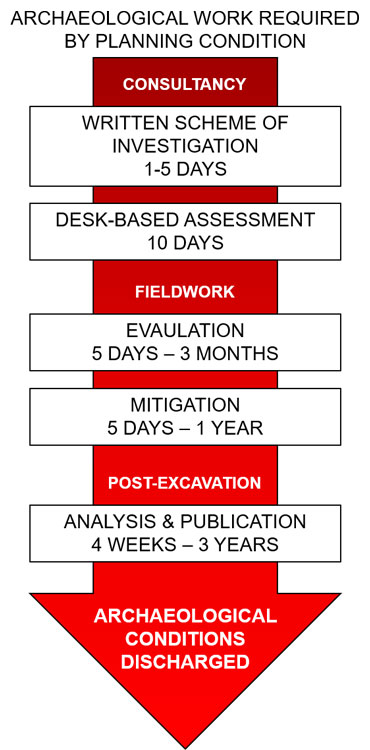University of Leicester Archaeological Services
Why do I need an archaeologist?
In the UK, archaeology is an integral part of the planning, development and construction process. However, sometimes its place within this process can appear quite confusing. This short guide helps explain the different stages involved and some of the terms that you may come across.
The historic environment is a fragile and finite resource. In the UK, legislation and planning guidance protects the historic environment and local government archaeological advisors guide planning authorities on the conservation of archaeological remains. This is controlled by the National Planning Policy Framework (NPPF) 'Section 16: Conserving and enhancing the historic environment', which places the emphasis on understanding and conserving the significance of heritage assets as part of sustainable development. This makes the need to consider historic environment constraints, impacts and benefits an imperative from the outset of the development process to avoid unexpected issues at key planning and construction stages.
Planning authorities will assess development plans for potential archaeological interest and impose conditions for the conservation of the historic environment in a manner appropriate to its significance. This usually take the form of conditions imposed on planning permissions or pre-commencement conditions on outline planning permissions.
- Archaeological remains: Archaeology is the study of human history and prehistory through the excavation of sites and the analysis of artefacts and other physical remains.
- Archaeological interest: There will be archaeological interest in a heritage asset if it holds, or potentially holds, evidence of past human activity worthy of expert investigation at some point
- Heritage asset: A building, monument, site, place, area or landscape identified as having a degree of significance meriting consideration in planning decisions, because of its heritage interest. It includes designated heritage assets and assets identified by the local planning authority (including local listing).
- Historic environment: All aspects of the environment resulting from the interaction between people and places through time, including all surviving physical remains of past human activity, whether visible, buried or submerged, and landscaped and planted or managed flora.
- Significance: The value of a heritage asset to this and future generations because of its heritage interest. The interest may be archaeological, architectural, artistic or historic. Significance derives not only from a heritage asset’s physical presence, but also from its setting. For World Heritage Sites, the cultural value described within each site’s Statement of Outstanding Universal Value forms part of its significance.
 Consultancy
Consultancy
An archaeological planning condition will typically indicate that no demolition or development can start before a programme of archaeological work has been carried out. The type of archaeological work will usually be detailed in the condition and, depending on the development, there may also be an additional brief from the planning archaeologist.
The planning condition will require the work to be explained in a Written Scheme of Investigation (WSI) which must be submitted to, and approved by, the local planning authority. The WSI sets out the scope of the work to be undertaken, explains the significance of the heritage asset, identifies research questions, and explains the methods to be used, the timetable of work, the programme of post-excavation assessment, analysis and reporting of finds, and the provision for long-term deposition of finds and records.
The planning condition will also ask for the nomination of a competent person or persons / organisation to undertake the work set out in the WSI.
If the significance of and/or impact to the heritage asset is unclear to the planning authority, they may ask for the submission of a Desk-Based Assessment (DBA). This could be to meet a planning condition, or as preparation for submitting a planning application. The DBA is a review of existing written, graphic, photographic and electronic information relating to the historic environment in order to identify the likelihood of any heritage assets being present, their significance and the potential impact to them by the proposed development.
Fieldwork
The planning condition might ask for an initial phase of evaluation. This might consist of one, or a combination of topographic/LiDAR survey, fieldwalking, geophysical survey, building survey and trial trenching. This could be to meet a planning condition, or as preparation for submitting a planning application. If little or no archaeology is found, evaluation alone may be enough to fulfil the condition.
If evaluation identifies archaeology, it will likely be followed by appropriate mitigation. This could be design alteration to the proposed development to protect the heritage asset, or a programme of controlled, intrusive fieldwork in advance of construction (excavation / strip, map and sample excavation), and/or monitoring during construction (watching brief).
Post-excavation work
The next phase of the archaeological process, conducted off-site, is the in‐depth analysis of the site data by a variety of archaeological specialists and the publication of the results. Depending on the size of the project this can take weeks to years to complete. Post-excavation work is as important as fieldwork and will possibly be a separate planning condition, which will request that provision be made for analysis, publication and dissemination of the results.
Finally, the artefacts, paper and digital archive will be deposited for perpetuity with an appropriate archiving authority (e.g. a local or national museum or archive depository). Provision for archive deposition will also be a planning condition.
Archaeological conditions will not be discharge by the planning authority until both the fieldwork and the post-excavation work have been completed.
Further information
- ULAS provides a full range of archaeological services throughout the UK. From consultancy, through to fieldwork and post‐excavation work. Our team of specialists, supported by academic expertise and facilities within the university offer a fast, efficient, and professional service.
- The Chartered Institute for Archaeologists has produced a guide: Professional archaeology: a guide for clients.
- Historic England has published guidance on how to preserve archaeological sites affected by development or other land-use change: Preserving Archaeological Remains: Decision-taking for Sites under Development.